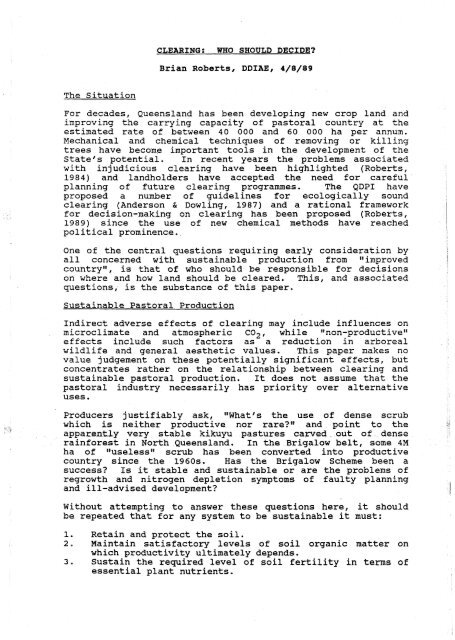soil-conservation-people-religion-and-land.pdf - South West NRM
soil-conservation-people-religion-and-land.pdf - South West NRM
soil-conservation-people-religion-and-land.pdf - South West NRM
Create successful ePaper yourself
Turn your PDF publications into a flip-book with our unique Google optimized e-Paper software.
CLEARING: WHO SHOULD DECIDE?<br />
Brian Roberts, DDIAE, 1/8/89<br />
The Situation<br />
For decades, Queensl<strong>and</strong> has been developing new crop l<strong>and</strong> <strong>and</strong><br />
improving the carrying capacity of pastoral country at the<br />
estimated rate of between 40 000 <strong>and</strong> 60 000 ha per annum.<br />
Mechanical <strong>and</strong> chemical techniques of removing or killing<br />
trees have become important tools in the development of the<br />
State's potential. In recent years the problems associated<br />
with injudicious clearing have been highlighted (Roberts,<br />
1984) <strong>and</strong> l<strong>and</strong>holders have accepted the need for careful<br />
planning of future clearing programmes. The QDPI have<br />
proposed a number of guidelines for ecologically sound<br />
clearing (Anderson & Dowling, 1987) <strong>and</strong> a rational framework<br />
for decision-making on clearing has been proposed (Roberts,<br />
1989) since the use of new chemical methods have reached<br />
political prominence.<br />
One of the central questions requiring early consideration by<br />
all concerned with sustainable production from ltimproved<br />
country", is that of who should be responsible for decisions<br />
on where <strong>and</strong> how l<strong>and</strong> should be cleared. This, <strong>and</strong> associated<br />
questions, is the substance of this paper.<br />
Sustainable Pastoral Production<br />
Indirect adverse effects of clearing may include influences on<br />
microclimate <strong>and</strong> atmospheric C02, while lfnon-productivell<br />
effects include such factors as a reduction in arboreal<br />
wildlife <strong>and</strong> general aesthetic values. This paper makes no<br />
value judgement on these potentially significant effects, but<br />
concentrates rather on the relationship between clearing <strong>and</strong><br />
sustainable pastoral production. It does not assume that the<br />
pastoral industry necessarily has priority over alternative<br />
uses.<br />
Producers justifiably ask, "What's the use of dense scrub<br />
which is neither productive nor rare?" <strong>and</strong> point to the<br />
apparently very stable kikuyu pastures carved out of dense<br />
rainforest in North Queensl<strong>and</strong>. In the Brigalow belt, some 4M<br />
ha of "useless" scrub has been converted into productive<br />
country since the 1960s. Has the Brigalow Scheme been a<br />
success? Is it stable <strong>and</strong> sustainable or are the problems of<br />
regrowth <strong>and</strong> nitrogen depletion symptoms of faulty planning<br />
<strong>and</strong> ill-advised development?<br />
Without attempting to answer these questions here, it should<br />
be repeated that for any system to be sustainable it must:<br />
1. Retain <strong>and</strong> protect the <strong>soil</strong>.<br />
2. Maintain satisfactory levels of <strong>soil</strong> organic matter on<br />
which productivity ultimately depends.<br />
3. Sustain the required level of <strong>soil</strong> fertility in terms of<br />
essential plant nutrients.
















